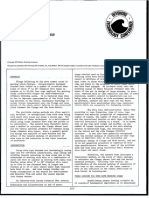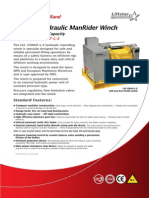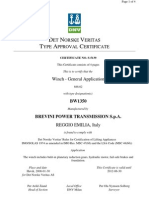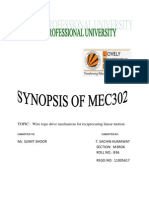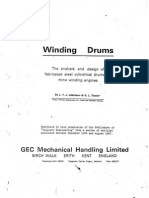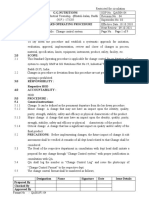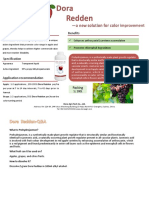Analysing Winch Systems With Finite Element Analysis
Analysing Winch Systems With Finite Element Analysis
Uploaded by
Ben RuffellCopyright:
Available Formats
Analysing Winch Systems With Finite Element Analysis
Analysing Winch Systems With Finite Element Analysis
Uploaded by
Ben RuffellCopyright
Available Formats
Share this document
Did you find this document useful?
Is this content inappropriate?
Copyright:
Available Formats
Analysing Winch Systems With Finite Element Analysis
Analysing Winch Systems With Finite Element Analysis
Uploaded by
Ben RuffellCopyright:
Available Formats
Ruffell, 2011
Using FEA for Winch Systems
Analysing Winch Systems With Finite Element Analysis Benjamin Ruffell School of Engineering, University of Waikato, Hamilton, New Zealand bdhr1@waikato.ac.nz
Abstract Some gliders use winches to launch them into the air. Winch owners have been changing from steel to nylon rope to reduce the mass of the rope, allowing higher release altitudes. However, the winch drums have been buckling after the launch, which has prompted the need for a means of modeling the behaviour of the rope on the winch. This paper presents a finite element model of a small scale experiment involving one turn of rope in the circumferential direction around a thin walled cylinder. Shear modulus reduced beam elements and 3D solid elements were used to represent the rope and drum, respectively. It was found that a quarter model with symmetrical boundary conditions was the only way to elude convergence issues. The hoop stress found during the small scale experiment matched the stress in the Abaqus model for the same load within seven percent. Future work could focus on finding the cause of failed convergence to allow analysis of multiple turns of rope.
1. Introduction
launches have become more popular in recent years. The winch pulls the glider along the runway, providing sufficient speed for takeoff. When the glider has reached a high enough altitude, the rope releases and falls to the ground. The launch can be summarised in six stages. Before ground roll, ground roll / lift, transition to climb, the climb, transition to level flight (cable release) and after cable release [1]. Steel winch ropes are most commonly used for this task, but are very heavy, causing the winch to have a large inertia and the rope between the glider and the ground to have a large sag. Reducing the mass of the cable would make it easier to stop the winch in an emergency situation and reduce the amount of sag, allowing higher release altitudes. Steel cables have been replaced with nylon to achieve these improvements. However, winches have been known to fail due to buckling after making this change in rope. The buckling usually occurs when the launch has finished, due to the retained tension in the rope. Synthetic rope has different frictional [2] and elastic properties to steel rope [3], which leaves the cause of winch failure open to speculation. Winches rely on friction of the rope to operate correctly and rope stretch so that the inner layers relax, relieving hoop stress. An accurate way of modeling winch systems is desired, with the ability to observe the effects of multiple layers, friction and rope stretch. Currently, winches are designed using empirical formulas that give a minimum cylinder wall thickness in terms of the number of layers and expected rope force [4]. They have been shown to be very conservative and make no compensation for the friction between the rope and cylinder or stretch of the rope. Also, a cylinder wall thickness does not always apply because of the variation in the designs of winches. It was proposed that Finite Element Analysis (FEA) could be used to model these characteristics. A literature review uncovered minimal past work in modeling rope using FEA and only one published journal article [5]. The published article presented a dynamic model for predicting the un-orderly windings that result when a winch is stopped suddenly. However, this ignored friction so the method could not be emulated.
INCHED GLIDER
This paper investigates the different ways of modeling rope systems in the FEA software, Abaqus. It details the material properties and contact conditions required for an accurate model. It also offers the results of an experimental model to validate the finite element model. 2. Methodology Because this paper is concerned with modeling the interaction between the rope and the winch drum, the first mile stone in the research was developing a model in Abaqus that accurately represented the behaviour of rope. Following this, an experimental model had to be constructed to obtain comparable data. Finite Element Model Several different models were constructed to establish the easiest and most accurate way of modeling rope. Truss elements were considered because they do not possess rotational degrees of freedom between elements, which means a bicycle chain type effect could be used to represent a rope if the elements were small enough. However, contact conditions could not be found to satisfy the truss to solid interaction. The only other way of providing near zero flexural rigidity was to use solid or beam elements with reduced shear modulus in the axial direction. The shear modulus was set to the smallest allowable value of 0.1 MPa in the property module by specifying the use of Engineering Constants instead of Isotropic. Assigning the appropriate material direction to solid elements proved too difficult to pursue. Instead, beam elements were used by sketching a circular path made up of small straight lines around the cylinder and assigning beam properties to them. This allowed material orientations to be easily assigned using the discrete option (Figure 1). The next step was inserting contact conditions. The outside surface of the drum was selected as the master surface while each segment of rope was selected as the slave node region. It is for this reason that node to surface contact was selected. The sliding formulation needed for the model to run was small sliding. Tangential and normal behaviour was selected using penalty friction method with a coefficient of 0.1. 1
Ruffell, 2011
Using FEA for Winch Systems
A general static step was used, with the initial increment size set to 0.01 in order for the non-linear analysis to run successfully. The rope was made up of 11 segments (allowing the rope to resemble a curve) with each segment having 5 elements. The quarter cylinder had a total of 720 elements with refinements made in the circumferential direction to increase the accuracy of the contact conditions (Figure 5).
The cylinder was held at each end within wooden constrains and was allowed to move around on the workbench in order to avoid extra stresses being induced in the cylinder due to rotation. The rope was anchored at one end, wrapped around the cylinder once and given tension from a boat winch (Figure 3).
Figure 3: Experimental set-up. The rope tension was measured with a force gauge and the hoop strains were recorded as the force was applied. The goal of the experiment was to establish a rope force to hoop stress relationship. 3. Results & Discussion Using the method outlined previously, a quarter symmetry Abaqus model of the experimental procedure was constructed. A rope force of 150 N was applied to the virtual model and run considering non-linear effects. The maximum stress in the wall of the cylinder was 48 MPa (Figure 5). This was coincident with the experimental model, which gave 58 MPa and 45 MPa at the top and bottom strain gauges, respectively (Figure 6). The increased stress at the top gauge is thought to be due to the downward force caused by the position of the fixed end of rope. If the average experimental stress is compared with the Abaqus model, it is accurate within 7%. The expected reaction force at the fixed end of the rope in the Abaqus model was expected to be 127.6 N according to eytelweins (capstan) equation for a coefficient of friction set to 0.1 (Figure 4). It was also seen that the reaction force would approach zero after 7 turns. Probing the reaction force in Abaqus revealed a reaction force of 128.3 N. This is within 1% of the expected value and shows that Abaqus can accurately model the friction of rope to drum contact.
Figure 1: Specifying material direction. Experimental Model A small experimental model was constructed using a milo tin with a height and diameter of 173 and 130 mm, respectively. Two strain gauges were glued on the inside directly opposite each other orientated to measure strain in the circumferential direction (Figure 2).
Figure 2: Strain gauge on the inside of the cylinder.
Ruffell, 2011
Using FEA for Winch Systems
Figure 4: Reduction in reaction force per turn.
Figure 5: Stress distribution in the drum wall with a rope force of 150 N.
Ruffell, 2011
Using FEA for Winch Systems
Figure 6: Hoop stress induced at each strain gauge during experimentation.
A model with one complete turn of rope could not be solved due to convergence issues; even after reducing the time step. Although a small quarter model was solved with accurate results, the incapability of modeling one or more turns means Abaqus could not be used in a practical winch analysis scenario. Even if several turns could be analysed and the reaction force confirmed using eytelweins equation, it is anticipated that modeling multiple layers would pose more difficulties and require more computing power. As multiple turns and layers are introduced, the points of contact increase. Internal layers of rope would have four points of contact: top, bottom and sides. Complicated contact conditions greatly increase the computation time, which stands to reason that generic FEA packages may not be ideal for analysing winch systems. However, if a finite element code could be written specifically for analysing winch systems then it could be a very useful design tool. This is because there are many different designs of winches and the ability to create a solid model of the drum and observe the effects of multiple layers of rope tightening around it, would remove the inaccuracies involved with the empirical equations currently used. Particularly with the case of the glider winch, the drum is very old and designed differently compared to other winches (Figure 7).
Figure 7: Glider winch drum. A purpose made FEA application for dealing with rope contact scenarios would mean that the effects of friction coefficients, rope stretch and rope size can all be assessed.
Ruffell, 2011
Using FEA for Winch Systems
4. Conclusions It has been shown that Abaqus is capable of accurately calculating the hoop stress in a cylinder due to a rope being wrapped around it. However, in this research it could only be achieved using a symmetrical model with rope no more than a quarter of the way around the cylinder. If the rope is longer than this, Abaqus had convergence issues. However, the stress found in the quarter symmetry finite element model was confirmed by the experimental model within 7% for a rope force of 150 N. The rope reaction force in the finite element model was validated within 1% by eytelweins equation for a coefficient of friction of 0.1. This showed that Abaqus is accurate at modeling the frictional contact between rope and winch drum. The cause of the convergence issues experienced when modeling a full rotation of rope were unable to be found during the allotted research time frame. If the source of this problem could be identified and appropriate remedies taken, FEA could be used to analyse winch systems irrespective of their rope, size or design. 5. Recommendations Future research in this area would require investigating the convergence difficulties that Abaqus faced when solving a full rotation and addressing them. If this cannot be done, a special purpose finite element program could be written that is devoted to analysing winch systems. 6. Acknowledgement I would like to thank Ilanko for supervising this research project, Yuanji for helping me prepare my rig for experimentation and Rainer for being helpful in providing information about glider winches when I needed it. 7. References 1. SANTEL, C.G., NUMERICAL SIMULATION OF A GLIDER WINCH LAUNCH. 2008, RWTH AACHEN UNIVERSITY: AACHEN. GILMORE, J., D. STENVERS, AND R. CHOU. SOME RECENT DEVELOPMENTS OF ROPE TECHNOLOGIES FURTHER ENHANCEMENTS OF HIGH PERFORMANCE ROPES. IN OCEANS 2008. 2008. BARRY, P., HIGH STRENGTH SYNTHETIC FIBER ROPE COMPARED TO WIRE ROPE FOR HELICOPTER LONGLINE APPLICATIONS. 2010. LIM BUAN TECK, D., IMPROVEMENT IN THE DESIGN OF WINCHES, IN MECHANICAL ENGINEERING. 2005, NATIONAL UNIVERSITY OF SINGAPORE: SINGAPORE. IMANISHI, E., T. NANJO, AND T. KOBAYASHI, DYNAMIC SIMULATION OF WIRE ROPE WITH CONTACT. JOURNAL OF MECHANICAL SCIENCE AND TECHNOLOGY, 2009. 23(4): P. 1083-1088.
2.
3.
4.
5.
You might also like
- Statistical Mechanics Homework 6 Prof. YuDocument6 pagesStatistical Mechanics Homework 6 Prof. Yupalison100% (4)
- Electronicboards - Q Management Accounting FunctionsDocument2 pagesElectronicboards - Q Management Accounting FunctionsBhavik Thakkar0% (1)
- A Practical Approach To The Leaning ColumnDocument9 pagesA Practical Approach To The Leaning ColumndeviationzNo ratings yet
- Final DocumentDocument20 pagesFinal Documentapi-307821649No ratings yet
- 03 Antropometri (Part 2) - TY-2020Document67 pages03 Antropometri (Part 2) - TY-2020uytyuytryuNo ratings yet
- Tolerances and FitsDocument12 pagesTolerances and FitskoitkulperNo ratings yet
- Shear Strength of High-Strength BoltsDocument61 pagesShear Strength of High-Strength Boltsloox600No ratings yet
- Modal Damping Estimates From Static Load-Deflection CurvesDocument8 pagesModal Damping Estimates From Static Load-Deflection CurvesJose ManuelNo ratings yet
- TGN 11 Clip Spacing 09-12Document2 pagesTGN 11 Clip Spacing 09-12kayakeras3335No ratings yet
- Rotek 84pgcat FINAL ViewOnly Swing Bearning1Document82 pagesRotek 84pgcat FINAL ViewOnly Swing Bearning1dsnsarmaNo ratings yet
- Old Technology: Roller Bearing Cranes Seatrax Kingpost Marine CranesDocument2 pagesOld Technology: Roller Bearing Cranes Seatrax Kingpost Marine CranesIrwan Diharjo0% (1)
- 200te Reel Hub DriveDocument3 pages200te Reel Hub Drivejohariak100% (1)
- Fixed Boom Marine Crane - EBIDocument3 pagesFixed Boom Marine Crane - EBIalikajbafNo ratings yet
- Deck Cranes Winches: Powerful - Vigorous - ReliableDocument7 pagesDeck Cranes Winches: Powerful - Vigorous - Reliableaiyubi2No ratings yet
- 266 NR - 2019 06 PDFDocument152 pages266 NR - 2019 06 PDFsaravana kumarNo ratings yet
- Buckling Análysis of Telescopic Boom PDFDocument7 pagesBuckling Análysis of Telescopic Boom PDFAndonny Daq DelgadoNo ratings yet
- Lecture No 5Document15 pagesLecture No 5Miruna ClinciuNo ratings yet
- Machine DesignDocument14 pagesMachine DesignSirajuddin A100% (1)
- Winch Brake Bands Design Considerations OCIMF Info Paper FDocument4 pagesWinch Brake Bands Design Considerations OCIMF Info Paper FSachin MatwankarNo ratings yet
- Otc 3669 MSDocument10 pagesOtc 3669 MSanon_401712377No ratings yet
- Ingersoll Rand - Hydraulic ManriderDocument2 pagesIngersoll Rand - Hydraulic Manridersh4kzyNo ratings yet
- CM Heavy-Duty Crane Hooks BrochureDocument12 pagesCM Heavy-Duty Crane Hooks Brochuretvmehta01No ratings yet
- Mechanical DesignDocument34 pagesMechanical DesignNiki LaudaNo ratings yet
- Double Wishbone SuspensionDocument5 pagesDouble Wishbone SuspensionalexmarieiNo ratings yet
- Mech 499 Project Virtual and Physical Prototyping of Mechanical Systems Web-Controlled Dog Ball LauncherDocument26 pagesMech 499 Project Virtual and Physical Prototyping of Mechanical Systems Web-Controlled Dog Ball LauncherParesh GoelNo ratings yet
- The Performance and Service Life of Wire Ropes Under Deep Koepe and Drum Winders Conditions - Laboratory SimulationDocument9 pagesThe Performance and Service Life of Wire Ropes Under Deep Koepe and Drum Winders Conditions - Laboratory SimulationRicardo Ignacio Moreno MendezNo ratings yet
- GD & T Limits Fits Course MaterialDocument45 pagesGD & T Limits Fits Course MaterialDivyarajNo ratings yet
- Power Strand Wire RopeDocument36 pagesPower Strand Wire RopeIqbal Gayuh RmsNo ratings yet
- Instruction Manual: TCR - MC TypeDocument20 pagesInstruction Manual: TCR - MC TypeKhaled RabeaNo ratings yet
- MAE Wheelset PressesDocument20 pagesMAE Wheelset PressesKhhg AgddsNo ratings yet
- Design and Mechanisn of Internal Gear PumpDocument13 pagesDesign and Mechanisn of Internal Gear PumpabhairulzNo ratings yet
- Bearing ReliabilityDocument3 pagesBearing ReliabilityWayu100% (1)
- Design Verification of Winch For Offshore Cranes PDFDocument4 pagesDesign Verification of Winch For Offshore Cranes PDFtonyNo ratings yet
- Desgn ProcdureDocument7 pagesDesgn ProcdureHairi MuhammadNo ratings yet
- 152 - HARDOX - 500 - UK - Data Sheet PDFDocument2 pages152 - HARDOX - 500 - UK - Data Sheet PDFneto-portoNo ratings yet
- Catalog AceDocument132 pagesCatalog AceLiana IsopelNo ratings yet
- Thread StrippingDocument3 pagesThread StrippingTony_SSANo ratings yet
- 66 04AK HADEF Manual Electric Chain Hoist Rev20 PDFDocument30 pages66 04AK HADEF Manual Electric Chain Hoist Rev20 PDFNenad PetrovicNo ratings yet
- An Introduction To Wire RopeDocument13 pagesAn Introduction To Wire Ropewindgust82No ratings yet
- Shrink FitDocument6 pagesShrink FitParag NaikNo ratings yet
- Sheave Design Versus Wire Rope LifeDocument2 pagesSheave Design Versus Wire Rope LifeSandeep GuptaNo ratings yet
- A Baseline 6 Degree of Freedom Mathematical Model of A Generic Missile - GoreckiDocument59 pagesA Baseline 6 Degree of Freedom Mathematical Model of A Generic Missile - GoreckispbhavnaNo ratings yet
- BW1350 DNVDocument4 pagesBW1350 DNVharmvdwNo ratings yet
- Auto Transmission Engg - Duty CycleDocument2 pagesAuto Transmission Engg - Duty Cyclevijay_khandgeNo ratings yet
- Block Rotation and Rope Stability PDFDocument3 pagesBlock Rotation and Rope Stability PDFAnshul AsthanaNo ratings yet
- 47 National Hydraulic Swaging MachinesDocument1 page47 National Hydraulic Swaging MachinesUrip S. SetyadjiNo ratings yet
- Sibre Crane Wheel SystemsDocument13 pagesSibre Crane Wheel Systemsdotsy11No ratings yet
- - PS00020345, 自卸车底盘(右舵英文版)Document286 pages- PS00020345, 自卸车底盘(右舵英文版)dekaeka90No ratings yet
- Why Consider Roller Screw TechnologyDocument2 pagesWhy Consider Roller Screw Technologyryasa1No ratings yet
- 2013 Wright Specifications CatalogDocument189 pages2013 Wright Specifications CatalogcenicercNo ratings yet
- Wire Ropes Drive Mechanism For Reciprocating Linear MotionDocument5 pagesWire Ropes Drive Mechanism For Reciprocating Linear MotionSachin KumawatNo ratings yet
- ChassisDocument42 pagesChassissarvenderrawat100% (1)
- Exemple Dinamic Factor As DNV GL For Offshore CranesDocument3 pagesExemple Dinamic Factor As DNV GL For Offshore CranesandreiwlNo ratings yet
- Ch04 Section17 Press and Shrink FitsDocument11 pagesCh04 Section17 Press and Shrink FitsIlario FabbianNo ratings yet
- Presented at The 2010 Annual SME Meeting in Phoenix, AZDocument15 pagesPresented at The 2010 Annual SME Meeting in Phoenix, AZassaNo ratings yet
- Factor of SafetyDocument4 pagesFactor of SafetySujit Mishra100% (1)
- Atkins On TaylorDocument55 pagesAtkins On Taylorbogdanostin0% (1)
- Thomson Glide ScrewDocument12 pagesThomson Glide ScrewRuben PauwelsNo ratings yet
- Hands-On Simulation Modeling with Python,: Develop simulation models for improved efficiency and precision in the decision-making processFrom EverandHands-On Simulation Modeling with Python,: Develop simulation models for improved efficiency and precision in the decision-making processNo ratings yet
- Structural Health MonitoringFrom EverandStructural Health MonitoringDaniel BalageasNo ratings yet
- The Finite Element Method for Three-Dimensional Thermomechanical ApplicationsFrom EverandThe Finite Element Method for Three-Dimensional Thermomechanical ApplicationsNo ratings yet
- Wind Wizard: Alan G. Davenport and the Art of Wind EngineeringFrom EverandWind Wizard: Alan G. Davenport and the Art of Wind EngineeringNo ratings yet
- CV PPCDocument3 pagesCV PPCHarrrisonNo ratings yet
- Kezia CVDocument4 pagesKezia CVcheckpointgermany.smgNo ratings yet
- Self Learning Material Grade 11 EnglishDocument70 pagesSelf Learning Material Grade 11 EnglishJamunanantha PranavanNo ratings yet
- URs For V-BlenderDocument11 pagesURs For V-BlenderTanChantrea100% (1)
- Assessing Operations Management From A Strategic PerspectiveDocument24 pagesAssessing Operations Management From A Strategic PerspectiveRakshita SolankiNo ratings yet
- Caterpillar Cat 312C and 312C L Excavator (Prefix BWH) Service Repair Manual Instant DownloadDocument29 pagesCaterpillar Cat 312C and 312C L Excavator (Prefix BWH) Service Repair Manual Instant DownloadshaneikaarvidsonNo ratings yet
- Jenny Everett - ANDE Presentation - Colombia August 2010Document26 pagesJenny Everett - ANDE Presentation - Colombia August 2010newventurescolombiaNo ratings yet
- WindCon BrochureDocument8 pagesWindCon BrochureErik RSNo ratings yet
- Steve McEwen Agent BrochureDocument41 pagesSteve McEwen Agent BrochureSteve McEwen100% (1)
- Lecturer3-Descriptive AnalysisDocument24 pagesLecturer3-Descriptive Analysishoangha43kdNo ratings yet
- MODULE 1. Fundamental of Games and Sports: VolleyballDocument4 pagesMODULE 1. Fundamental of Games and Sports: VolleyballPrichebelle Gerona GrafiaNo ratings yet
- Nab Traveller Card Cashout FormDocument1 pageNab Traveller Card Cashout FormjackwbattleNo ratings yet
- Weighment of Agricultural Commodities in APMCs Through Electronic Weighing SystemDocument4 pagesWeighment of Agricultural Commodities in APMCs Through Electronic Weighing SystemInternational Journal of Innovative Science and Research TechnologyNo ratings yet
- Yearly Return For Unexempted Establishment (Form 3 A) Form3aYearlyDocument1 pageYearly Return For Unexempted Establishment (Form 3 A) Form3aYearlyRavi AdakiNo ratings yet
- GG SOP QA004 Change Control System OkDocument9 pagesGG SOP QA004 Change Control System OkMishra DiveshNo ratings yet
- Class 6 - Week 1 - IT - LP - IcebreakerDocument7 pagesClass 6 - Week 1 - IT - LP - IcebreakerShalaka MainiNo ratings yet
- Santa Claus Is Coming To Town-Arrangement For Wind Orchestra-Bassoon - 1-Partitura - y - PartesDocument35 pagesSanta Claus Is Coming To Town-Arrangement For Wind Orchestra-Bassoon - 1-Partitura - y - Partesmavila.escmusicaNo ratings yet
- Jurnal Reading Dermatitis KontakDocument14 pagesJurnal Reading Dermatitis Kontaksulesa askawiNo ratings yet
- RFP DCA Annexures Kosi BridgeDocument293 pagesRFP DCA Annexures Kosi BridgePPPnewsNo ratings yet
- 2025 2027 SyllabusDocument22 pages2025 2027 Syllabusarti kaleeswaranNo ratings yet
- Ifrs Unit 3Document15 pagesIfrs Unit 3Deven LadNo ratings yet
- Annual Report 2020 2021Document80 pagesAnnual Report 2020 2021Victor Takayama GarciaNo ratings yet
- SCM MPPT Solar Charge Controller 48V100A 300A TelecomDocument2 pagesSCM MPPT Solar Charge Controller 48V100A 300A TelecomRaed Al-HajNo ratings yet
- On The Sustainability of LocalDocument32 pagesOn The Sustainability of LocalAnanya MishraNo ratings yet
- Dora Redden IntroductionDocument5 pagesDora Redden IntroductionLily LiNo ratings yet
- 4th Week 1Document5 pages4th Week 1一人で ユーリ100% (1)
- Survey QuestionnaireDocument3 pagesSurvey QuestionnairehNo ratings yet
- Numerical Test 5: AssessmentdayDocument31 pagesNumerical Test 5: AssessmentdaySong ToànNo ratings yet



















